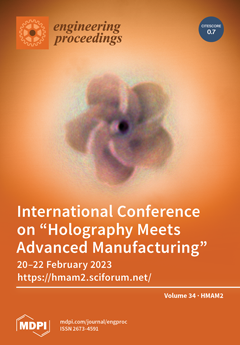Eng. Proc., 2023, HMAM2 2023
International Conference on “Holography Meets Advanced Manufacturing”
Online | 20–22 February 2023
Volume Editors:
Vijayakumar Anand, University of Tartu, Estonia
Amudhavel Jayavel, University of Tartu, Estonia
Viktor Palm, University of Tartu, Estonia
Shivasubramanian Gopinath, University of Tartu, Estonia
Andrei Bleahu, University of Tartu, Estonia
Aravind Simon John Francis Rajeswary, University of Tartu, Estonia
Kaupo Kukli, University of Tartu, Estonia
Vinoth Balasubramani, King Abdullah University of Science and Technology (KAUST), Saudi Arabia
Daniel Smith, Swinburne University of Technology, Australia
Soon Hock Ng, Swinburne University of Technology, Australia
Saulius Juodkazis, Swinburne University of Technology, Australia
Printed Edition Available!
- Issues are regarded as officially published after their release is announced to the table of contents alert mailing list.
- You may sign up for e-mail alerts to receive table of contents of newly released issues.
- PDF is the official format for papers published in both, html and pdf forms. To view the papers in pdf format, click on the "PDF Full-text" link, and use the free Adobe Reader to open them.




